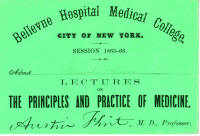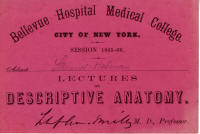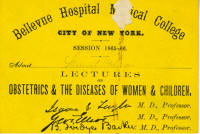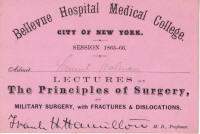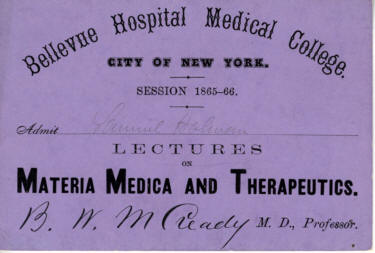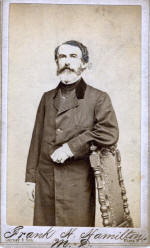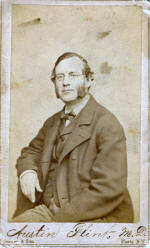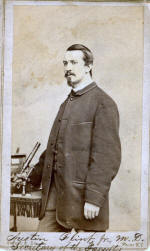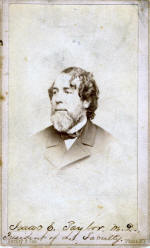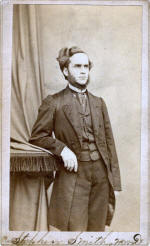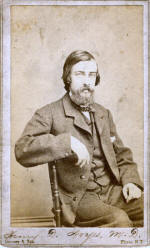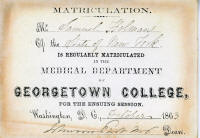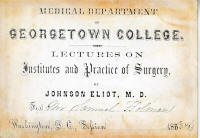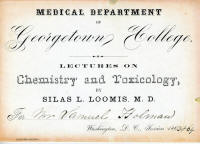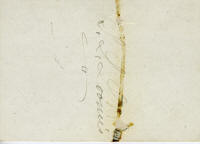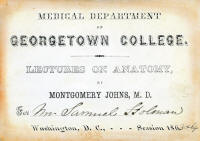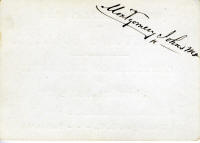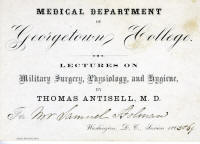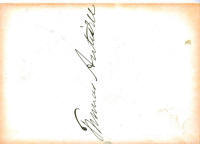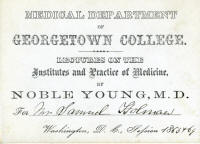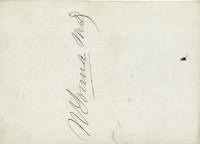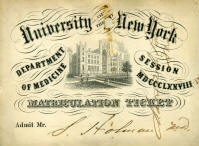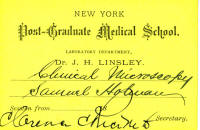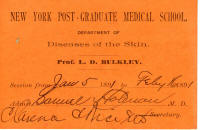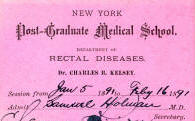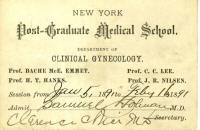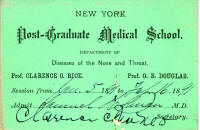Bellevue Hospital Medical College, 1862-1863
Medical Department of Georgetown College, 1863-64
University of New York, Department of Medicine
New York Post-Graduate Medical School 1891
Lecture Cards and Faculty CDV's for Bellevue Hospital during the Civil War
Medical Student:: Samuel Holman
Bellevue Hospital Medical College opened its doors in the spring of 1861, with the following physicians as the faculty: Stephen Smith, Frank H. Hamilton, James R. Wood, Alexander B. Mott, Lewis A. Sayre, Isaac E. Taylor, Fordyce Barker, George T. Elliot, Jr., Benjamin W. McCready, J.W. S. Gouley, Austin Flint, Austin Flint, Jr., and Robert O. Doremus.
The original building was on the grounds of Bellevue Hospital, but the school soon realized they needed a larger building, and in 1865-66, a larger building, also on the hospital grounds, was erected at 419-21 East 26th Street. In addition to serving as the home for the College, the facility was also used by the Bureau of Medical and Surgical Relief for the Out-door Poor.
During the Civil War, physicians from Bellevue Hospital Medical College , under the auspices of the United States Sanitary Commission, published several monographs for Army surgeons, such as Stephen Smith's piece on "Amputations." Faculty members also played significant roles on New York City 's Council of Hygiene and Public Health, whose landmark report on the sanitary condition of the city led to the establishment in 1866 of the New York City Department of Health.
The surgery department of the college was strong, and included prominent doctors such as Lewis Sayre, who was the first professor of orthopedic surgery in the country. In 1854 he performed the first successful resection of the hip joint in the United States . Frank Hamilton was an authority on fractures, and wrote the first complete and comprehensive treatise in English on the subject.
Bellevue Hospital Medical College Lecture Schedule & Faculty List: 1862-63
Medical Student: Samuel Holman
During the Civil War, Samuel Holman served as an Assistant Surgeon in the Union Navy aboard the ship: U.S.S. WYALUSING. See additional Civil War notes and information on Samuel Holman
Name: Samuel Holman
Death date: Mar 4, 1910
Place of death: Rochester, NY
Type of practice: AllopathBellevue Hospital Medical College Lecture Schedule & Faculty List: 1862-63
Schedule and Faculty list shown with leather pocket holder for lecture cards: 1865-66
Austin Flint, M.D. Henry D. Noyes, M.D.
James R. Wood, M.D. B. W. McCready, M.D.
Stephen Smith, M.D. Isaac E. Taylor, M.D.
From the Med. Surg. History: Acting Assistant Surgeon Stephen Smith also reports the case as a "gunshot wound through bladder."
Lewis A. Sayre, M.D. Austin Flint, Jr., M.D.
Alexander B. Mott, M.D. Frank H. Hamilton, M.D
Frank H. Hamilton, M.D organized the U. S. General Hospital, New York city, in 1862, and in February, 1863, was made medical inspector, U. S. army, with the rank of lieutenant colonel. He resigned his military connections in September, 1863 Military History. — Brigade Surgeon U. S. Volunteers, August, 1861. Chief Surgeon and Medical Director 4th Corps Army of the Potomac, October, 1861, to September, 1862. Charge of General Hospital, New- York City, December, 1862, to February, 1863. Lieutenant-Colonel and Medical Inspector, February, 1863. In the Department of the Cumberland, to August, 1863. Resigned? August, 1863.
Alexander B. Mott, M.D. 1863; Brigade Surg., 2d Brig. N. Y. State Militia, 1861-62; Surg. U. S. Vols., 1862, at U. S. Gen. Hosp., N. Y. with multiple references in the Med. and Surg. History.
R. Ogden Doremus, M.D. Benjamin W. McCready, M. D.
Medical Department of Georgetown College, 1863-64
Medical Student: Samuel Holman*
FACULTY, 1865-66.
NOBLE YOUNG, M. D., President, Professor of Principles and Practice of Medicine.FLODOARDO HOWARD, M. D., Treasurer Professor of Obstetrics and Diseases of Women and Children.
JOHNSON ELIOT, M. D., Dean, Professor of Principles and Practice of Surgery.
JAMES E. MORGAN, M. D., Professor of Materia Medica and Therapeutics.
THOMAS ANTISELL, M. D., Professor of Military Surgery, Physiology and Hygiene.
MONTGOMERY JOHNS, M. D., Professor of General, Microscopic and Descriptive Anatomy.
SILAS L. LOOMIS, M. D., Professor of Chemistry and Toxicology.
D. R. HAQNER, M. D., Lecturer on Clinical Medicine.
W. EVANS, M. D., Demonstrator of Anatomy.
Matriculation
At the call of President Lincoln, Dr. Eliot was among the first local surgeons who volunteered their services, starting for the battlefield of Bull Run with a pass to the front signed by Secretary of War Stanton, not waiting for a commission. Here he busied himself with the sick and wounded of both armies, amputating when necessary, dressing wounds.
In 1862 Surgeon Loomis was appointed assistant surgeon U. S. A., and accompanied the Union army of Gen. McClellan from Fortress Monroe to Harrison's Landing, and afterwards stationed at the United States general hospitals. He is also cited in the Medical and Surgical History.
Military Surgery, Physiology, Hygiene
At the outbreak of the Civil War, Thomas Antisell entered the Union army as a Brigade Surgeon. He not only served in the field, but was surgeon in charge at Harewood, a large Civil War Hospital.
From the M & S History: Dr. Thomas Antisell, medical director of the division, charged with duties beyond the immediate command, was active and prompt in the discharge of all; Brig. Surg. Vols., Med. Director First Div. And Chief of Hospital at Strasburg; Surgeon Antisell, medical director of the corps, and Surgeon Chapel, medical director of First Division, are entitled to high commendation for their excellent preparations made for the wounded, and their faithful attention to them at the hospital depots: On the retreat of the rebels under Jackson, I was ordered, on June 3, 1862, by Surgeon Thomas Antisell, U. S. V., to the Academy general hospital, where I had charge of the rebel and union wounded until July 12th, when, the hospitals of Winchester being discontinued, I was ordered to fake fifty-eight patients to Harper's Ferry, and report myself for duty at the hospital of that post. See the extended information on Surgeon Antisell cited in the Medical and Surgical History....
Dr. Morgan took charge of the Soldiers' Rest, an institution for the reception of sick and disabled soldiers on their way from the Union armies in the South.
A 'Private Pupil' card for Samuel Holman signed by:
Frank H. Hamilton, 1865
At the beginning of the Civil War Surgeon Hamilton accompanied the 31st New York regiment to the front, and had charge of the general field hospital in Centreville during the first battle of Bull Run. In July, 1861, he was made brigade surgeon, and later medical director, and in 1862 organized the United States general hospital in Central park, New York. in February, 1863, he was appointed a medical inspector in the United States army, ranking as lieutenant-colonel, but resigned in September and returned to his duties in Bellevue hospital medical college, where in 1861 he had been appointed professor of military surgery and attending surgeon to the hospital.
Dr. Holman returns in 1878-79 to attend a lecture by Isaac E. Taylor, M.D.
University of New York, Department of Medicine
No longer a student at Georgetown, Samuel Holman, M.D. also attended University of New York
New York Post-Graduate Medical School 1891
Medical Student: Samuel Holman, M.D. Surfaces once again in post-graduate school
J. H. Linsley, M.D. L. B. Bulkley, M.D. Charles B. Kelsky, M.D.
Dr.'s C. C. Lee, Emmet, Nilsen, Hanes, Rice, Douglas
Lecture Ticket and Medical College Index
Lecture Card Collection..:
1a | 1b | 2 | 3 | 4 | 5 | 6 | 7 | 8 | 9 | 10 |
11 | 12 | 13 | 14 | 15 | 16 | 17 | 18 | 19 | 20
Civil War medical authors and faculty
in this collection with their biographies





